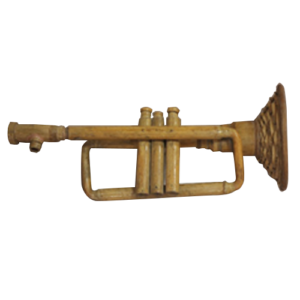Acoustic analysis of BMI sound
In the current Philippine setting, the manufacturers of bamboo musical instruments (BMI) and the musicians who use them have the most say in determining and evaluating the quality of sound produced by the bamboo instruments. Manufacturers and musicians describe the sound of each instrument using specific timbral descriptors that appear to be common among themselves. The intensity of select timbral descriptors specifies the overall sound quality of a BMI.
Sound quality provides a distinction between sounds that have the same pitch and loudness. The term sound quality descriptors (SQD) refer to the adjectives that describe the sound of a Himig Kawayan instrument. There are specific descriptors defined for each instrument illustrated below.
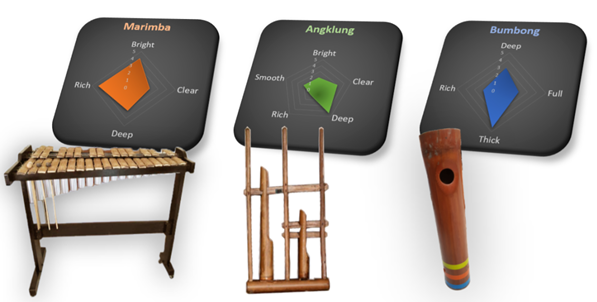
The sounds of non-traditional BMI were collected during field works. Audio recording sessions using a high-quality portable microphone allowed the team to obtain excellent audio samples of existing non-traditional BMIs currently used in performances and concerts. Upon recording the samples, a noticeable timbre difference between instruments defines the signature sound of an instrument maker.
Seen on the images below are the microphone positions and the musician’s role during data collection. Each performer is required to play staccato and legato for their assigned BMI. It is important to produce the optimum sound representing the instrument’s signature sound, given that it is the sound that we want to describe.
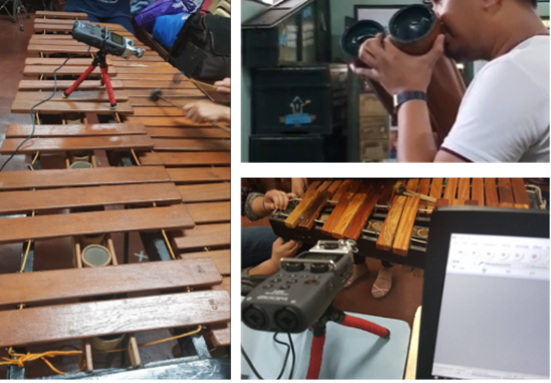
After data collection, the team trimmed and organized the audio data to construct a BMI dataset of these recordings. Through acoustic analysis, the sound features of each sample were used as input to a mathematical model to have an in-depth understanding of the SQD scores. The overall process of learning and interpretation of each audio sample is illustrated in the figure below.

In this example, a sample recording of a marimba bar is used as an input. It is followed by a feature extraction process that provides an input signal’s spectral, temporal, spectro-temporal, and harmonic features. The temporal features describe the time domain representation. On the other hand, the spectral features cover the frequency domain representation of the whole signal. In addition, a local per frame analysis on the signal using short-duration windows gives information on the consistency of these features. Together with statistical analysis, this technique adds more features that are deemed helpful for the mathematical model. Lastly, the signal harmonics expose the existence of harmonic partials, which significantly contribute to the sound quality of the BMI.
These features are used to train a model with supervised learning utilizing surveyed SQD scores as labels for each audio data. Multiple iterations of training optimize the model and reduce the root-mean-square error between the predicted scores and the scores provided by the respondents. It is expected that the model learns the significance of each feature to the descriptor.
In general, given a signal recording, the system is expected to determine the SQD scores of each timbral descriptor. An overall description of a BMI sound is obtained using this method. The following sections show how the vibration characteristics contribute to these sounds.
Experimental modal analysis (EMA)
The vibration characteristics of a BMI gives supporting details about the sound produced. The team extracted the modal parameters — natural frequencies, damping ratios and mode shapes — of the instrument prototypes using experimental modal analysis (EMA). Shown below is a roving impact hammer experiment of an A6 marimba bar, which is the selected test sample for the project.
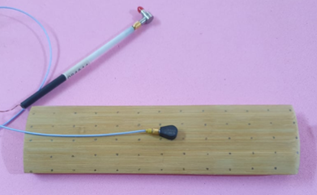
Two sensors are used for the experiment: (1) impact hammer and (2) accelerometer. Both are connected to a data acquisition module that records the mechanical force applied to the bamboo bar and the generated movement. From similar studies, the bar is expected to vibrate differently if struck at different points which is the concept of the roving impact hammer experiment.
To be precise, dots are drawn on the bamboo marimba bars as strike points for the impact hammer. Each hit excites a wide spectrum of frequencies of the bar. The frequency response of each impact point exposes different natural frequencies of the bar. In effect, modal parameters of the bar are extracted using a curve fitting method.
The whole sequence is processed offline using a MATLAB application after converting the raw accelerometer data. Then, a selected data file with corresponding impact points assign particular elements of a matrix variable corresponding to the ticked boxes. The “Extract Data” button executes the assignment. The frequency response function at each point is computed using the data from the impact hammer and the accelerometer. Using the “Compute Modes” button, the application determines the EMA modal parameters.
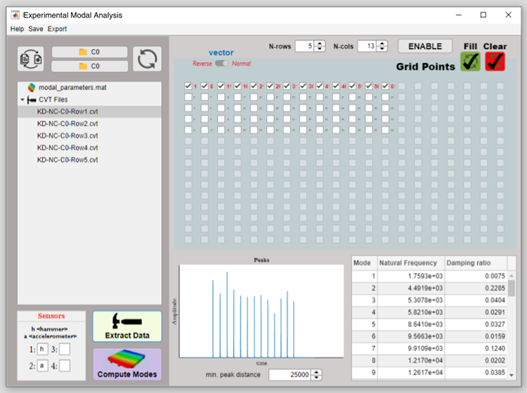
In the application, the height of the peaks recorded refers to the strength of impact applied to the bamboo marimba bar. Also, a table of modal parameter values measured which includes the natural frequencies and the damping ratios, are listed. It measures up to fifty modes and significant ones are utilized for the vibration characteristics.
Lastly, we determine the natural frequencies that contribute to the timbre or the sound quality of the bamboo marimba bar. In similar studies, if the vertical and the torsional modes are too close to each other, the strength of vibration of the mode’s natural frequencies interferes with the other. This causes a less audible sound to that particular harmonic partial emitting a different sound quality if fine-tuned appropriately. Shown in the table below are the modal parameters of a bamboo marimba bar for a Giant Bamboo – kiln dried – with nitrocellulose finish (1 coating) extracted using EMA. This will later on be confirmed on the simulation experiments which validates the use of finite element analysis (FEA) to suggest prototypes in developing a good sounding bamboo marimba bar.
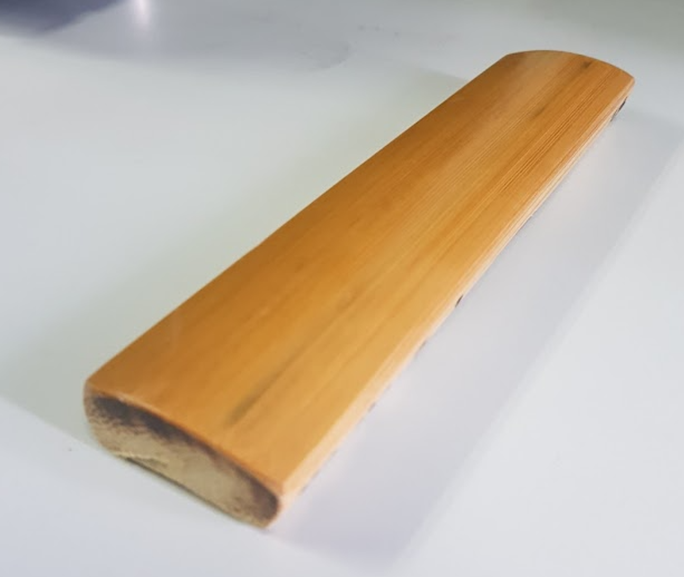
Modes | Natural Frequencies | Damping Ratio | Mode Shapes |
V1 (2,0) | 1764.4 | 0.0091 |  |
V2 (3,0) | 5040.4 | 0.0263 |  |
T2 (2,1) | 7524.6 | 0.0301 |  |
V3 (4,0) | 8791.9 | 0.0219 |  |
The team also tried to determine the modal parameters of an angklung resonator. Illustrated below are the select mode shapes from using the same experiment.
Finite element analysis (FEA) in COMSOL
Instead of extracting vibration modes from actual prototypes, modeling and simulation can also be used to determine the modal parameters. The process of finite element analysis is shown in the flowchart.

The geometry of the BMI is constructed using simple volume objects such as rectangular prisms and hollow cylinders. Creating the exact material requires adding or removing materials from the initial object. For example, a parabolic undercut is removed below the rectangular prism to create a similar shape to the existing geometry of a marimba bar.
Density, Young’s modulus, and Poisson ratio are material properties specified for the model. The values obtained from flexural tests of the bamboo prototypes are used as reference. For finite element analysis, the effect of dimension and material properties to the vibration characteristics of the BMI is observed. Determining the modal parameters, mostly natural frequencies, gives an understanding on the sound quality of the BMI. The contribution of these vibrating modes of a material when a force is applied shows the possible sound that it could create.
The experiment involves sweeping all these parameters and shows its effect on the fundamental frequency and the harmonics of the BMI. An illustration below shows the vibration modes of a bamboo marimba plate and the corresponding frequency response of the sound.
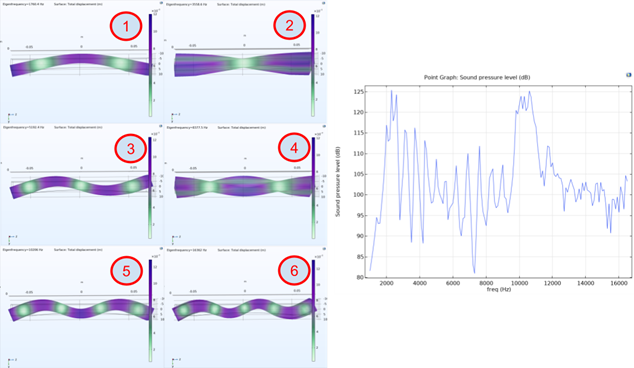
The model suggests possible geometries for actual prototype development, especially fine tuning the sound of a bamboo musical instrument. This method lessens the cost of creating prototypes in terms of materials and labor. Although it is difficult to obtain the actual mechanical and material properties of a bamboo, simulation suggestions would still give a rough estimate on the expected sound of the BMI.
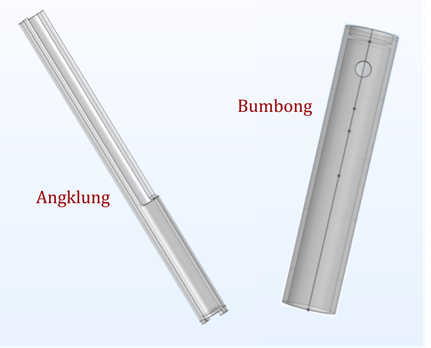
The prototype development process creates an innovative BMI that could withstand storage problems and pests while maintaining a good sounding instrument. Given different processing technologies were applied to the final output, acoustic and vibration analysis would expose their effects to the sound. Further exploration on the effects of the processing technologies to the angklung resonator would show how it will affect the sound of the angklung.
Science in a creative industry.
The DOST-FPRDI has a Bamboo Musical Instruments Innovation R&D program aimed at improving the quality of locally-made bamboo musical instruments (BMIs) through science and innovative technologies. The program seeks to standardize the production of selected BMIs, develop prototype designs, analyze raw material sources and existing markets, and build a BMI processing facility. In addition, the program aims to document the ethnocultural story behind several BMIs and identify the bamboo species used in BMI production to promote public awareness and appreciation of the cultural importance of these musical instruments. The program is a collaboration with the University of the Philippines and Philippine Normal University for teaching modules and analyzing sound quality and standardization of BMI design. The DOST Grants-in-Aid program provides funding.
PhBMI



